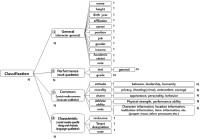
Purpose Soccer-related social media BigData includes complex information related to soccer players and is continuously and instantly generated. Text mining research is actively carried out for this kind of social media contents analysis, but it tends to be analyzed with limited linguistic characteristics such as understanding of language complexity and context, ambiguous terms, rhetoric, and new terms. This can be attributed to the fact that the tools commonly used for text mining use universal terminology dictionaries and packages that exclude the peculiarities of the analysis themes. The purpose of this study is to develop an Ontology model, which are representative tools for defining semantic ambiguity and relationships and systems between terms of text data. Methods In order to achieve the research objectives, we applied the 7-step development method of ‘Ontology Development 101: A Guide to Creating Your First Ontology’, which is useful for ontology development. Each step includes 1) Determine the domain and scope of the ontology 2) Consider reusing existing ontology 3) Enumerate important terms in the ontology 4) Define the classes and the class hierarchy 5) Define the properties of classes-slots 6) Define the facts of the slots 7) Create instances. In particular, the 3rd-step of this study, the glossary stage, is to extract core terms that make up he ontology, but since the goal of this study is to develop the ontology that can be used in social media contents analysis of soccer players, we conducted a social media text analysis related to actual soccer players and selected 484 core terms. Results The ontology which was developed in this research for social media contents analysis of soccer players consisted largely of four parts(General terms, performance results terms, common terms, and Characteristic term) and classified according to the content characteristics of the term. Conclusion Developed ontology in this study is object-oriented that defining classes and objects to define divisions and relationships between terms and also means a social media contents knowledge system of soccer players. In addition, it performs a function as a secondary tool which can be utilized for atypical data analysis.

Purpose The purpose of this study is to identify the consistency and correlation of referee evaluation according to the judging characteristics in the preliminary and semi-final of the Latin event of dance sports, thereby deriving the problem of referee reliability and suggesting alternatives for improvement. Methods The method of study is Based on the performance data of 54 amateur Latin dances match organized by the Korea Dance Sports Federation for a total of three years 11,850(preliminary rounds & semi-final). Based on the Kappa statistics and the degree of agreement(pa), the difference in the group of examination characteristics was derived and the correlation between the five Latin events was analyzed. Results As a result of through this study, the consistency of the dance sports referee and the characteristics of the judging in the event were confirmed, and the number of judges tended to be higher when the number of judges was seven, the more the number of subjects was, and the highest level of agreement was more than 70 percent of the judges. In addition, the higher the concordance of each of the five detailed items, the higher the correlation tendency. Conclusion Differences in visual aspects between dance sports judges and the difference in the judges' ratings due to the revision of the rules, the decrease in the number of competitors participating in the competition, the number of people to be eliminated in each round, and the proportion of judges with experience in the competition are different, and these differences affect the judges and show up in the scores. The Latin dance sports events based on objectivity and reliability to improve the correct standards of judges to find the same raters, work will be required and an assessment element. With a systematic way in and to carry out the review curriculum and educational development is considered necessary.
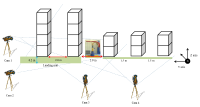
Purpose The purpose of the study was to perform a comparative analysis of the YANG Hak Seon technique carried out by "K" athlete with the kinematical data of "Y" athlete and propose a method to improve the YANG Hak Seon technique of "K" athlete. Method The subject recruited for the study was a male athlete from Korean national team (Age: 21, height: 1.65 m, body weight: 59.6 kg, and career: 11 years). Four high - speed cameras were used to analyze the 3D motion of the YANG Hak Seon technique performed by "K" athlete. The variables selected for analysis were the velocity of COM, displacement of COM, the rotational & torsional angle of the trunk and rotational & torsional angular velocity of the trunk. The results obtained were compared to the preexisting data of the "Y" athlete (data set from the published research). Results Firstly, the horizontal displacement of the YANG Hak Seon technique of the "K" athlete was observed to be shorter along with lower vertical displacement during landing compared to “Y” athlete. In addition, the overall horizontal velocity was low and vertical velocity was not generated which rises during the BC (board contact) phase. Although the rotational angular velocity of the trunk was lower during the BC, HC (horse contact) phase and LD (landing) phase, torsional angular velocity was higher during the LD. Conclusion In order to improve the completeness of the YANG Hak Seon technique of the K player, it is necessary to enter with a fast and low posture on the footplate during the initial phase. In the BC phase, it is essential to raise the COM simultaneously while landing on the footplate and increase the rotational angular velocity of the trunk.


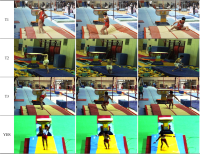

Purpose The purpose of this study was (1) to analyze judges’ evaluation on rhythmic gymnastics performance by applying generalizability theory and (2) to suggest recommendations to improve judges' rating. Methods Data were 34 players’ scores from Senior Part at 29th KGA President’s Cup National Rhythmic Gymnastics Championship in Korea. Difficulty and execution scores in ball, clubs, hoop and ribbon event were analyzed. Analysis models containing components of area and reputation rank were designed and multivariate generalizability theory were used for analysis. Results The G-study results showed (1) that the error source about players has more significant impact to evaluation than other error sources in analysis model containing components of only player and judge, (2) that the error source about players has more significant impact to evaluation than other error sources in analysis model adding components of area, but the error source about area has more significant impact to evaluation of clubs event than other error sources, (3) that the error source about players has more significant impact to evaluation than other error sources in analysis model adding components of reputation rank, but the error source about reputation rank has more significant impact to evaluation of hoop event than other error sources in analysis model adding components of area. The D-study results showed generalizability coefficient was stable in analysis model without components of area and reputation rank, but generalizability coefficient in analysis model containing components of area and reputation rank not stable in some event. Conclusion Recommendations for improving judging were discussed.

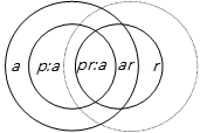

The aim of this study was to evaluate gender differences of expert and non-expert in match playing time, moving distance, energy consumption and heart rate (average, maximal) during 16 simulated badminton matches in male (n = 16) and female (n = 16) national elite players. The players had perform three sets on same day, and this time observed the playing time, moving distance, energy consumption and heart rate (resting, average, maximal) level during badminton match. Analyses of variance with repeated measures were used to test any significant time×group interaction effects on the measured variables. Statistical significances were tested at p = 0.05 with spss-pc (version 18.0). As a result, male's player had significantly difference between expert and non-expert in moving distance (p=.012), energy consumption (p=.003), average heart rate (p=.002) and maximum heart rate (p=.002). Female's players showed significant difference between expert and non-expert in moving distance (p=.001) and energy consumption (p=.012). In conclusion, there seemed to be an increased playing intensity (i.e., moving distance, energy consumption, average heart rate and maximum heart rate) from expert than non-expert in gender differences. These results suggest that men male's players with expert performed the game at a higher intensity than compared to non-expert, on the other hand female's player with non-expert showed that more activity and energy consumption was unclear during the game
PURPOSE This study examined whether K-league fans’ responses to game outcomes align with reference-dependent preference and loss aversion principles. METHODS We collected user comments from the 2023 K-league game highlights videos on YouTube. We identified each user’s supporting team and excluded neutral fans’ comments. Sentiment analysis using KoBERT was applied, and estimated sentiment scores served as dependent variables. We performed panel regression to test whether unexpected wins and losses generate positive and negative comments. RESULTS First, an unexpected win generates more positive comments, and an unexpected loss generates more negative comments; a reference-dependent preference exists. Second, the difference between the coefficient on upset win and the absolute value of the coefficient on upset loss is not statistically different; loss aversion does not exist. CONCLUSIONS The findings derive a deeper understanding of sports viewership and explain the difference between domestic and overseas sports fans. Also, the findings provide insights into the domestic professional sports business.
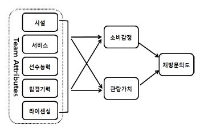
The purpose of this study was to provide managers and owners of Korea professional baseball teams with the necessary information for improving managerial performance by fan acquisition and retention. This paper chose LG, Nexen, and SK fans over the age of 17 as population of this study who visited at least twice home games held in the Jamsil, Mokdong, and Munhak baseball stadium. For the analysis of data, 413 questionnaires were used using SPSS 15.0 Windows and Amos 7.0. To examine respondents demographics traits, frequency analysis was processed and reliability analysis, confirmatory factor analysis and correlation analysis for relationship among the variables were conducted. Also, convergent validity analysis and discriminant validity analysis were made. Finally, path analysis was made for the verification of model suitability and of research hypotheses through structure equation modeling. The research results are as per the below. First, team attributes like physical facilities, team performance and licensing had significantly positive influence on consumption emotion. Second, team attributes like service and team performance significantly positive impact on viewing value. Third, consumption emotion had significantly positive impact on revisit intention. Fourth, viewing value had significantly positive impact on revisit intention.


PURPOSE This study aims to identify how the [Goal Kicking Women] TV program has changed the perceptions of male viewers on women’s football. METHODS Using a qualitative research design, semi-structured interviews were conducted with 8 male viewers who are in their 50s. Thematic analysis was used to draw implications from the interviews. RESULTS Results show that having watched [Goal Kicking Women], 1) participants have become more familiarized with women playing football; 2) participants’ initial stereotype about women’s alleged inferiority in football has changed, as the performance of female stars in the program, who did not have any experience playing football, improved; and 3) the genuine passion that female stars showed for football made participants think that women’s football was just as good as men’s. CONCLUSIONS This study provides practical and academic implications, as it identifies men’s perceptions on women’s football and analyzes the influence of [Goal Kicking Women]. To conclude, establishing a foundation for planning and implementing effective policies to promote women’s football in South Korea is recommended.
PURPOSE This study investigated the correlation between anaerobic power and maximum muscle strength in relation to core muscle strength among Korean national golfers. METHODS A total of 96 national golfers (53 females and 43 males) participated in the study. Body composition was assessed using multi-frequency impedance devices, while core and lower extremity muscle strength (extension, flexion, flex/ex ratio) was measured using isokinetic strength tests. Anaerobic power was evaluated through peak power, average power, and power drop rate tests conducted on bicycle ergometers, along with one-repetition maximum (1RM) tests for squats and bench presses. Mean and standard deviation values were calculated for all variables, and linear regression analysis was performed to verify correlations, with statistical significance set at α=.05. RESULTS The comparison of physical characteristics between male and female national golfers revealed significant differences in age, height, body fat percentage, lean body mass, and weight. There was a strong correlation between core muscle strength and isokinetic lower extremity muscle strength. Additionally, a strong correlation was observed between core muscle strength and anaerobic power and between peak power and average power. Furthermore, there was a high correlation between core muscle strength and bench press and squat maximum muscle strength. CONCLUSIONS This study highlights the correlation between various professional physical fitness variables of Korean national golfers over the past decade. The findings are expected to provide valuable insights for coaches and players in developing future training programs.
PURPOSE This study aimed to verify the accuracy of three-dimensional (3D) motion data produced through artificial intelligence-based user motion recognition technology with images obtained using a smartphone monocular camera. This was done to explore the possibility of developing an application that can improve the reliability of the measurement of physical activity performing motions and feedback provision. METHODS To check the accuracy of the artificial intelligence-based 3D motion analysis system that utilized a semi-supervised learning method, a commercialized 3D infrared motion analysis system measured and compared motions on three movement planes, motions with limited joint movement, and fast motions in a wide moving range. RESULTS The motions on the coronal and sagittal planes produced through the 3D motion analysis application showed very high measurement accuracy; however, the accuracy of the measurement of motions on the horizontal plane, which could not be measured directly with a camera, was relatively lower than that of the coronal and sagittal planes. Accuracy in measuring 3D motion was moderate in moving motions and low in motions with limited joint movement. CONCLUSIONS For the developed 3D motion analysis system to be used in online physical education, the types of physical activities included in the program should be comprehensively composed through the analysis of the content system of the physical education curriculum and the resultant physical activities.